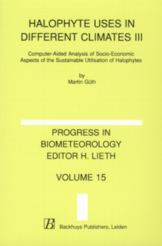

Population growth and economic
development have led in many countries with an arid or semi-arid climate to
scarcity of fresh water and arable land. Due to overuse and improper management,
ground water and soils become saline. Salt-tolerant plants (halophytes) enable
salt-affected ground water and land to be kept in use or to be put into use.
Freshwater resources can then be saved. Potential uses range from the production
of food and animal feed to use in landscape management and nature conservation.
The present study shows that halophytes are already in use all over the world
and efforts to extend utilisation have been increased in recent years. However,
information about economic feasibility is scarce and often based on single experiences.
But the existing examples demonstrate that halophyte utilisation can be not
only technically but also economically feasible. The economically motivated
utilisation of halophytes emerges as an interdisciplinary task. Besides the
natural conditions and properties of the species, economic and social constraints
determine the technology and economic success. In particular, aspects of irrigation
turn out to be crucial parameters. The control of soil salinity has top priority
in saline irrigation. Wherever irrigation is necessary and where the use of
halophytes has to compete with the use of common species, saline irrigation
needs to be more cost-efficient than the conventional use of fresh water. Depending
on the location, the potential to save costs can be immense. Halophytes can
be of extraordinary value in times of drought and feed gaps. Landscaping with
halophytes can reduce costs while providing benefits equal to the use of common
species. A rough assessment of locations via screening for potential to profit
from halophyte utilisation can be made if basic characteristics of the location
and expected plant performance are known. Locations should especially be taken
into consideration if halophytes can be used there at very low cost, if there
is an urgent need to solve the problem of salinated water resources or soil,
or if the current water supply is extremely expensive. Due to the unique characteristics
of halophytes, their use shows external effects that differ from the use of
common species. They may be positive as well as negative. In any case, they
need to be recognised. Especially politicians have to be aware of the benefits
halophyte utilisation can deliver to the society and should support the utilisation
adequately.
Software has been implemented for this study to facilitate the economic analysis
of halophyte utilisation. It applies dynamic methods of investment theory and
is designed to keep the number of boundary conditions to a minimum. Examples
demonstrate its functionality.
Although several halophytic species are already used successfully, this study
makes clear that, in many cases, further dissemination of halophyte utilisation
needs more research and field trials for experimentation and demonstration.
Most halophytes grow only wild up to now. The potential to improve their characteristics
to be used as a crop is immense and should be exploited by scientists. Field
trials need to be analysed under economic aspects. Costs and, if applicable,
profitability need to be documented. The circumstances of these factors also
need to be sufficiently transparent.